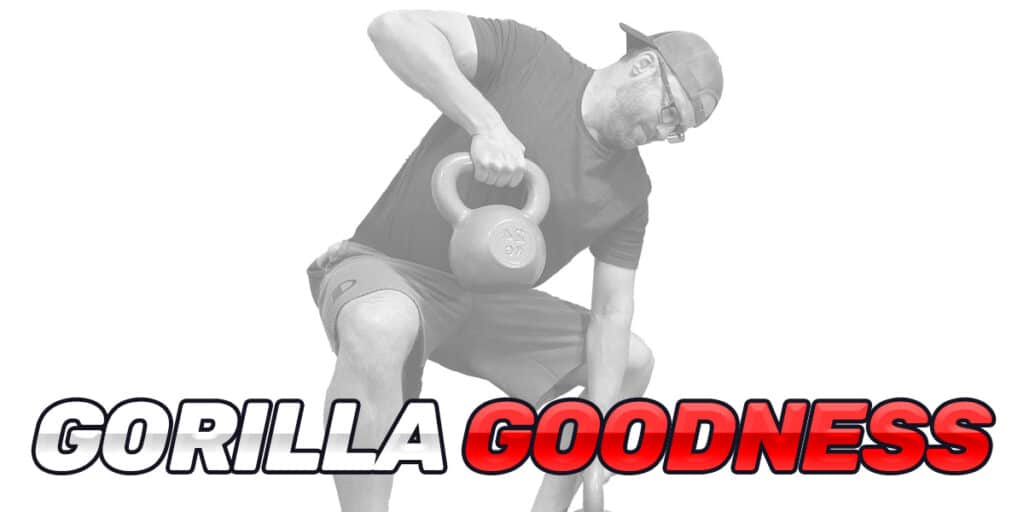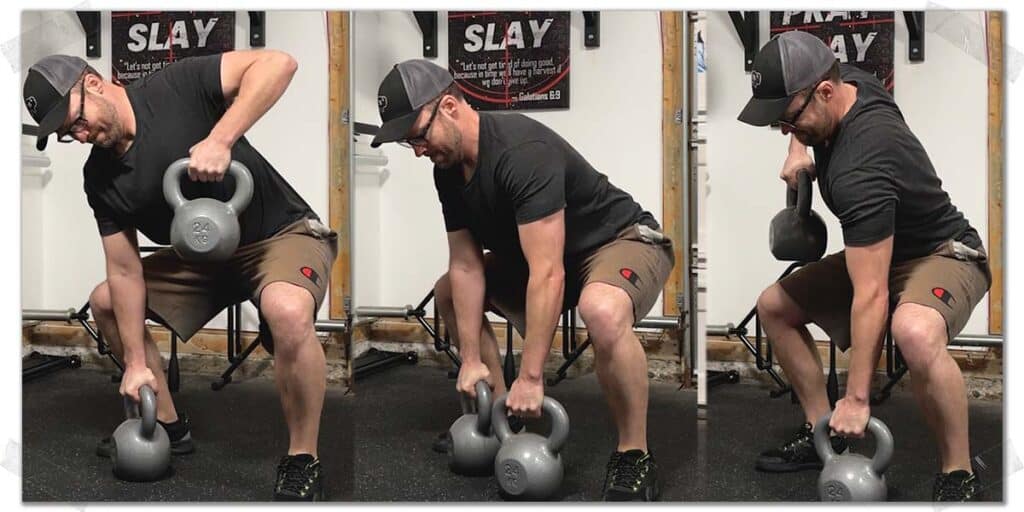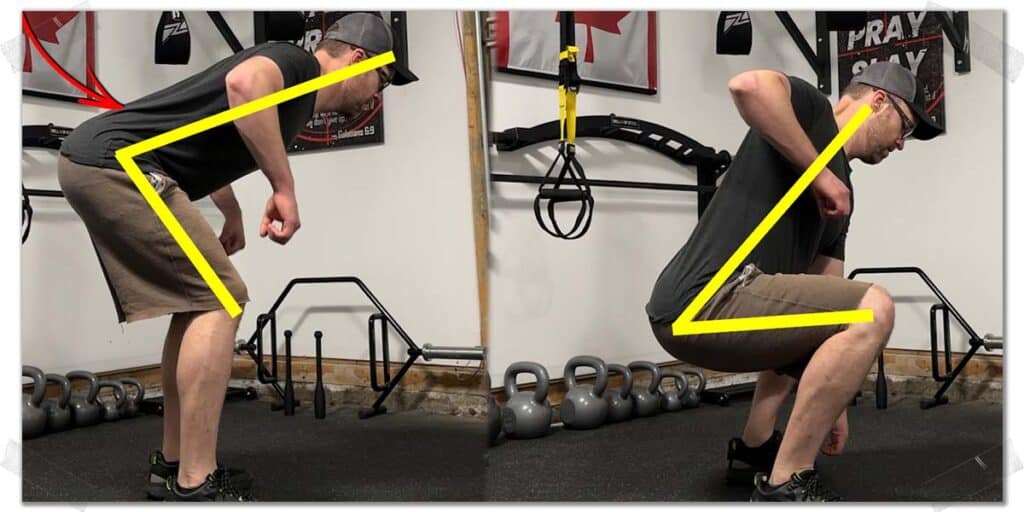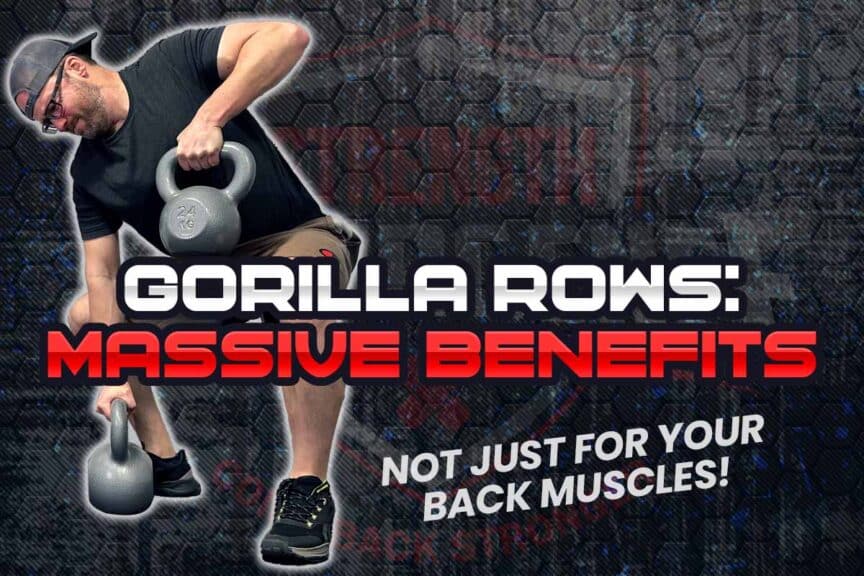Who doesn’t love exercises that build brutal full-body strength and endurance? Not only do exercises like these turn you into a more physically robust and capable human being, but they also improve your mental fortitude as you grind your way through them. Not a bad combination, eh? Personally, I’d contend the world would be a bit better off if more of these exercises were performed.
One such exercise (and one that you likely haven’t heard about or, at least, tried) that I’d love to see the world perform more is the gorilla row. And boy, oh boy, if you haven’t tried this exercise, you’re in for a nice surprise.
The gorilla row is a full-body exercise that not only strengthens the upper, middle, and lower back muscles but also simultaneously challenges the endurance of your quadriceps and gluteal muscles in your legs. It’s typically performed with kettlebells as either a double or single-arm exercise.
It’s truly one of those exercises that you’ve got to try for yourself; with the right weight selected and the ideal repetition range performed, it will leave your legs shaking and burning while your upper back gets lit up in the process.
So, let’s break down what makes this such an outstanding exercise and how to get the most out of it.

A small request: If you find this article to be helpful, or you appreciate any of the content on my site, please consider sharing it on social media and with your friends to help spread the word—it’s truly appreciated!
Why: The need for another type of row
To be clear, there’s nothing wrong with traditional barbell, dumbbell, or cable rows, so don’t think I’m suggesting such a thing. Rather, every exercise has a time and a place, and the gorilla row just might be the exercise of choice when looking to throw in some unique training challenges (or exercise variety) not found with other rows.
It’s perhaps a bit of a niche row, so there may be plenty of times when it’s more ideal to stick with more traditional upper-body pulling exercises instead.
As an example, the weight you can row will be limited by the strength and endurance of your legs, so if you’re in a strength phase or intensification phase of your training, it might not stimulate your back to the extent you want since your lower body may be the limiting factor here.
As such, this isn’t an exercise you’ll likely perform if you are looking to handle some seriously heavy weight for your back. You’ll still be able to handle and move that weight, but you’ll quickly realize that your legs will greatly determine just how many reps you can bang off in the process.
Therefore, this type of row is perfect for those looking for ways to expose weak links between their upper and lower body, those who are in more of an accumulation phase of their training, or those who want exercises that stimulate numerous muscle groups for time-efficient training.
Let’s quickly look at how to perform this exercise, then get to the juicy benefits it offers (those of you with a history of lower back pain will definitely want to read this section).
Related article: Horizontal vs Vertical Rows: Differences & Benefits of Each
How to: Performing the gorilla row

The standard gorilla row is quite straightforward to perform. You’ll find it works best with kettlebells, but dumbbells can also get the job done if needed.
Here’s how to perform the gorilla row:
- Place two kettlebells together on the ground and straddle them so that your feet are in a wider-than-shoulder-width stance.
- While keeping your spine flat (don’t let your chest collapse toward the floor), bend your knees so that you can reach down and grab the kettlebells. Your arms should be hanging directly beneath you.
- Pull one kettlebell directly upward as high as you can toward your armpit. Slowly lower it down to the floor and then immediately begin to repeat the process with the other arm in an alternating fashion.
- Keep your motion consistent at all times; don’t pause until your last repetition has finished.
Pro tip: If you are feeling truly sadistic, keep the kettlebells suspended in the air, hovering slightly off the floor, at all times throughout your set. Your legs will hate you by the end of your set, but you’ll be rewarded with some seriously robust hip and thigh endurance.
“With the gorilla row, you’ll quickly realize that your legs will greatly determine just how many reps you can bang off in the process.”
Related article: The Best Renegade Row Alternatives: Five Awesome Variations to Try
Massive benefits: Here’s what to know
Not only is the gorilla row a time-efficient exercise and one that’s relatively simple to perform, but it’s also one that challenges the body and mind in a manner that other pulling-based exercises can’t, at least not when it comes to using very basic strength equipment.
Let’s look at a few particular ways the gorilla row stands out from the crowd and what makes these features so unique for those looking to build full-body strength and endurance.
Benefit 1: Torso angle & low back health

One of the most unique features of the gorilla row is how it strengthens the muscles of the upper back, middle back, and even the lower back. This is due to the angle that the torso is held throughout the exercise. In a moment, I’ll discuss why this is such a big deal, particularly for those with dodgy lower backs.
The gorilla row is more of a full upright row (which is very upper trapezius dominant) but also has flavours of a horizontal row mixed in since the torso is held at a forward angle (albeit more of a mild one), ensuring some activation from the scapular-retracting muscles (the rhomboid major and minor).
But the real kicker is the challenge that the low back muscles (the erector spinae group) undergoes throughout the exercise since they have to prevent the torso from collapsing forward. This means they receive constant stimulation (albeit not aggressive amounts) whenever you’re in the gorilla stance (i.e., a sumo stance) and must then work even harder as you row the weight upward toward your chest.
This makes the exercise perfect for lifters, athletes, and active individuals who need to be mindful of their lower backs. Traditional rowing exercises such as bent-over barbell rows can be rather taxing on the lower back and, therefore, may not be tolerated by those with lower back issues.
Other traditional exercises, such as single-arm rows on a bench, don’t provide any stimulation for the lower back muscles at all. Now, this is not a bad thing by any means, as there are plenty of times when focusing purely on the mid-upper back while not stimulating the spinal erectors is ideal.
However, for lifters and athletes who may want to take higher levels of stress off their lower back but still stimulate these muscles (for injury prevention, rehabilitation, etc.), the gorilla row fits the bill perfectly.
Benefit 2: Simplicity & confidence
The added beauty of the gorilla row is its simplicity. While an exercise such as bent-over rows requires more body awareness and technique to perform (in terms of keeping the lower back safe), the gorilla row is much more manageable to complete for those who do not have the technique, ability, or confidence to perform bent-over rows.
When learning how to perform free-standing pulling exercises, I often start many of my athletes and patients with the gorilla row. The mild forward lean will begin to condition their lower back but won’t do so in an aggressive fashion. Additionally, this torso position is much more natural to hold and, as such, allows for more optimal execution and subsequent training results.
Benefit 3: Leg endurance for days

Muscular endurance simply refers to the ability of muscles to resist becoming tired. When you do the gorilla row, you force the muscles of the hip and leg (notably the gluteus maximus, quadriceps, and adductor muscles) to hold an intense contraction as you pull the weight up.
During the gorilla row, your legs are producing an isometric contraction (contracting but not producing movement) throughout the exercise. Assuming you perform this exercise with a moderate tempo and typical repetition range (perhaps between 5-10 repetitions per arm), this means you’ll not only be holding your squat for approximately 45-60 seconds (which can be challenging enough), but you’ll essentially be holding a weighted isometric squat, which will undeniably roast your legs.
Benefit 4: Mental fortitude
Whether you’re an athlete, a physically active individual, or someone who simply desires to challenge their physicality, you’ve probably learned throughout your pursuits that working out and physically pushing yourself to become stronger requires some serious mental fortitude.
If you use exercises to increase your mental strength, holding a weighted squat for as long as you can is one of the best exercises you can do to mentally toughen yourself up by pushing through physical fatigue. The burn here is real, and your ability to mentally dig deep and tell yourself to keep going will indeed be challenged. I know of no other rowing-based exercise that is as mentally taxing to grind through as the gorilla row.
So, keep this exercise in the back pocket of your mind for the times when you need a good finishing exercise to finish off your workout and empty the tank—physically and mentally.
Final thoughts
The gorilla row is a niche row, but one that, under the right circumstances, holds numerous benefits unique to rowing exercises while producing solid adaptations to lower body endurance and upper body strength.
If you need a bit of variety in your strength training or are looking for a good full-body strengthening exercise to perform, the gorilla row might be just what you’re looking for.

Hi! I’m Jim Wittstrom, PT, DPT, CSCS, Pn1.
I am a physical therapist who is passionate about all things pertaining to strength & conditioning, human movement, injury prevention and rehabilitation. I created StrengthResurgence.com in order to help others become stronger and healthier. I also love helping aspiring students and therapists fulfill their dreams of becoming successful in school and within their clinical PT practice. Thanks for checking out my site!

